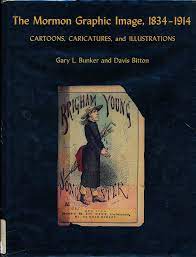Articles/Essays – Volume 16, No. 4
When Mormons Had Horns | Gary L. Bunker and Davis Bitton, The Mormon Graphic Image, 1834-1914: Cartoons, Caricatures, and Illustrations
After reading The Mormon Graphic Image, 1834-1914, you will understand why Mormons once had horns. The vestigial appendages were a remnant of cartoonists’ repeated use of the symbol to associate polygamy with satyr-like lust. The now-laughable image is the husk that re mains when a stereotype has metamorphosed into a prejudice.
But not all stereotypes are as comical or as easily dismissed, as authors Gary L. Bunker and Davis Bitton argue in their his tory that explores the image of Mormons in cartoon and line drawings during a period of our national experience when Mormons drew a large share of editorial venom. Motivated by similar studies of blacks, Jews, and native Americans, Bunker and Bitton set out to reveal how selectively and one-sidedly the nation’s editors portrayed Mormons during a time when America willfully ridiculed minorities. Al though many old images of Mormons seem to have faded, the authors also suggest that prejudices linger on the memory of stereo types. Problems arise when stereotypes are not completely relegated to folklore.
Bunker and Bitton divide their work into two parts. The first part explores the graphic treatment Mormons received during specific periods between 1834 and 1914. Then, the authors explore such themes as how Mormons, feminists, and communists were lumped together as troublesome bed fellows by political cartoonists.
Four-color illustrations are generously sprinkled throughout the book. The use of white space is lavish and gives the cartoons the critical display necessary to make them forceful and vital for the reader. More over, the white space gives the book a con temporary feel.
However, the book suffers from improper organization. In the last chapter the authors talk generally about the uses and abuses of stereotyping. But the reader needs to know beforehand how stereotyping is necessary in political cartooning. When dealing with mass audiences, stereo types provide a redundancy that better ensures broad communication, a helpful use. An earlier discussion would have enabled the reader to better discern the differences between malice and clever exaggeration.
It also would have been helpful had the authors provided some data on the publications. They reproduce often from The Wasp, Puck, Life, and The Daily Graphic, but the reader has no idea about the nature of their audiences or, with the exception of a circulation figure for Puck toward the end of the history, their scope and penetration. Life, for instance, billed itself as the magazine for the sophisticate. If that is so, how then did such stereotypes as “Mormons have horns” become fact for the uninformed and perhaps illiterate? In short, the authors also needed to discuss how images are communicated vertically through our social structure.
But if for no other reason, this book is an eminent success because of the exhaustive research undertaken by the authors. In addition to the analysis of the cartoons reproduced in the book, the authors often allude to other cartoons with prejudicial stereotyping. Tantalized by the rich material already presented, the reader wants to see those other cartoons himself, to ratify the authors’ judgment of what the symbols mean.
For there always is a problem in trying to decide what symbols mean. The riddle is compounded, too, when the analysts are separated by time from the material. For instance, the authors refer to a Currier and Ives presidential campaign print for the 1856 Republican candidate, John C. Fremont. Suggesting that the Republicans hoped to capitalize on the national ill-will toward Mormons, Bunker and Bitton say, “In the background on the top of the Rocky Mountains flies an American flag, suggesting that if the Republicans prevailed, Americanism not Mormonism would be firmly planted in that area” (p. 109). But is that, in fact, the 1856 interpretation? Could it have rather re minded the electorate that in 1845 Fremont explored the Mexican Territory in the Rocky Mountains and was heroically responsible for planting the Stars and Stripes on the previously foreign-held land?
But such strained interpretations are rare. Aware of their charge, the authors carefully provide scholarly distance from their supercharged material. It is that squarely drawn boundary that makes this history so valuable.
Cliches aside, it should be read by everyone, in Utah at least. The Utah gentile will discover how easily stereotypes become prejudices and how unconsciously ingrained they can become. At first, the gentile may find himself arguing with the authors, questioning whether stereotype and prejudice actually exist in a particular cartoon; but eventually, he or she will not be able to hold out against the overwhelming evidence. And coming to that realization, that reader will learn how one must be ever alert, lest stereotypes become real, personal perceptions.
The Mormon reader first will experience a catharsis. Then, if not content to rest on vindication, the Mormon reader in Utah will understand more of a curious phenomenon. He or she will see that stereotyping is a human condition and that the persecuted has the potential to become the persecutor when power is on his or her side.
The Mormon Graphic Image, 1834-1914: Cartoons, Caricatures, and Illustrations by Gary L. Bunker and Davis Bitton (Salt Lake City, Utah: University of Utah Press, 1983), 140 pp., $20.


 Back to full Issue
Back to full Issue

